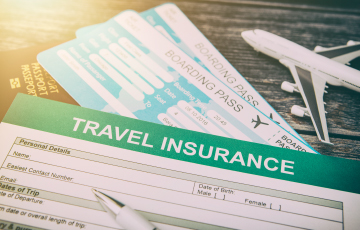Buying Travel Insurance for the First Time: Everything You Need to Know
Acquiring travel insurance for the first time need not be an intimidating endeavor. Armed with an understanding of the various types of coverage, a thoughtful consideration of key factors, and a grasp of policy intricacies, you can confidently set forth on your journey. It's important to recognize that travel insurance is more than just a precautionary measure; it serves as a dependable companion, ensuring a seamless and worry-free adventure. To demystify the process, just familiarize yourself with the diverse types of coverage available with Travelner Insurance.
Getting travel insurance is a simple process, requiring an understanding coverage types, key factors, and policy intricacies.
1. What is Travel Insurance?
Travel insurance is a financial protection product designed to mitigate the risks and uncertainties associated with various aspects of travel. It serves as a safeguard for travelers by providing coverage for a range of unforeseen events and emergencies that may occur before or during a trip.
Travel insurance policies are typically offered by insurance companies, travel agencies, or as standalone products, and they can be customized to meet the specific needs of individual travelers and their journeys.
2. How Many Types of Travel Insurance?
The significance of selecting the right travel insurance extends beyond mere financial protection; it extends to the preservation of the overall travel experience.
A well-chosen policy acts as a companion, allowing you to traverse the globe with confidence. Let's explore the difference types of travel insurance with Travelner Insurance.
Selecting the right travel insurance is crucial for preserving the overall travel experience.
2.1. Travel Insurance for Emergency Medical:
Travel insurance for emergency medical coverage is a type of insurance that provides financial protection and assistance in case you experience unexpected medical emergencies while traveling.
This coverage is designed to help you with the potentially high costs of medical treatment, hospitalization, and related expenses that may arise due to illness or injury during your trip. The key features of travel insurance for emergency medical coverage typically include:
- Medical Expenses: Covers the costs of necessary medical treatment, including hospital stays, surgeries, prescription medications, and doctor visits.
- Emergency Evacuation: Provides coverage for the expenses associated with emergency evacuation to the nearest adequate medical facility or repatriation to your home country if medically necessary.
- Repatriation of Remains: Covers the costs of transporting your remains to your home country in the unfortunate event of death during the trip.
- Pre-existing Conditions: Some policies may cover pre-existing medical conditions, while others may have exclusions or limitations. It's important to review the policy terms and conditions carefully.
2.2. Travel Insurance for Baggage:
Travel insurance for baggage is a type of coverage that provides financial protection in case your luggage is lost, stolen, or delayed during your travels.
This type of insurance aims to reimburse you for the value of your belongings and provide assistance in replacing essential items if your baggage is delayed for an extended period. The key features of travel insurance for lost or delayed baggage typically include:
- Lost or Stolen Baggage: Reimbursement for the value of your belongings if your luggage is lost or stolen during your trip. This coverage may include personal items such as clothing, electronics, and other essentials.
- Baggage Delay: Compensation for necessary purchases of clothing, toiletries, and other essential items if your baggage is delayed for a specified period. This helps cover the immediate costs of replacing items while you wait for your luggage to be delivered.
Travel insurance for baggage provides financial protection in case of loss, theft, or delayed luggage.
2.3. Travel Insurance for Trip Cancellation and Interruption:
Travel insurance for trip cancellation and interruption provides financial protection in the event that you need to cancel or cut short your trip due to unforeseen circumstances.
This type of insurance can help you recover some or all of the non-refundable expenses associated with your travel plans. It typically covers a range of situations that may disrupt your trip, such as illness, injury, death, or other unexpected events. The key features of travel insurance for trip cancellation and interruption include:
- Trip Cancellation: Reimbursement for non-refundable trip expenses if you are forced to cancel your trip before it begins. Covered reasons for cancellation often include illness, injury, the death of a family member, or other unforeseen events specified in the policy.
- Trip Interruption: Coverage for expenses incurred if you have to cut short your trip and return home unexpectedly. Like trip cancellation, covered reasons for trip interruption are typically outlined in the policy and may include medical emergencies, family emergencies, or other specified events.
- Cancel for Any Reason (CFAR) Coverage: Some policies offer an optional "Cancel for Any Reason" (CFAR) add-on, which provides more flexibility in canceling your trip for reasons not explicitly listed in the standard policy. CFAR coverage may have specific conditions and limitations.
2.4. Travel Insurance for Pre-Existing Conditions:
Travel insurance for pre-existing conditions is a type of coverage that addresses the medical needs of individuals who have existing health conditions at the time of purchasing the insurance.
Pre-existing conditions are typically defined as medical conditions or illnesses that exist or have been diagnosed before the effective date of the travel insurance policy. The key features of travel insurance for pre-existing conditions include:
-
Coverage for Existing Health Conditions:
This type of travel insurance is designed to provide coverage for medical issues that you already have when you purchase the policy.
It may include coverage for exacerbations of pre-existing conditions or unexpected complications related to those conditions.
-
Medical Emergency Coverage:
The insurance may cover expenses related to medical emergencies arising from pre-existing conditions, such as hospitalization, doctor visits, and prescription medications.
Travel insurance for pre-existing conditions addresses the medical needs of individuals with existing health conditions.
The realm of travel insurance encompasses a broad and diverse spectrum. Opting for the most suitable coverage guarantees that you are well-equipped to face unforeseen circumstances, granting you the peace of mind to concentrate on crafting indelible and cherished memories during your travels.
3. Explore The Common Features on Travel Insurance That You Need to Know When Buying Travel Insurance for The First Time
By taking the time to comprehend policy jargon and thoroughly reviewing inclusions and exclusions, you can make an informed decision when purchasing travel insurance that fit your needs for the first time.
3.1. Policy Jargon:
When you buy travel insurance for the first time, you might be unaware of the risks and uncertainties that can arise during your trip.
So, understand your requirements for a travel insurance policy that fits your needs. However, understanding your demands is not enough, you should consider the terms or the jargon in the policy to ensure this will support your adventure thoroughly.
Here are a few common terms you should understand:
- Premium: The amount you pay for the insurance coverage.
- Deductible: The amount you need to pay out of pocket before the insurance coverage kicks in.
- Coverage Limits: The maximum amount the insurance company will pay for a covered loss.
- Policyholder: The person who owns the insurance policy.
- Claim: A request for the insurance company to cover a loss or expense.
- Pre-existing Condition: A medical condition that existed before the start of the insurance policy.
3.2. Policy Inclusions and Exclusions:
Reviewing carefully the inclusions and exclusions is a crucial step to knowing what is included and excluded in your travel insurance policy. Moreover, you should familiarize yourself with key terms, and reading the fine print ensures that you know exactly what you are covered for and what falls outside the policy's scope.
These are common inclusions and exclusions:
- Inclusions:
- Emergency Medical Coverage: Coverage for medical expenses incurred during your trip.
- Lost Baggage: Compensation for lost, stolen, or damaged baggage.
- Exclusions:
- Pre-existing Conditions: Some policies may not cover pre-existing medical conditions.
- High-Risk Activities: Certain adventurous activities may not be covered unless specified.
- Unapproved Destinations: Some regions may be excluded from coverage due to safety concerns.
- Intoxication or Drug Use: Incidents related to alcohol or drug use may not be covered.
Understanding the inclusions and exclusions of your travel insurance policy is crucial.
4. Advice for First-Time Travel Insurance Buyers
For those venturing into the realm of travel insurance for the first time, navigating the options can be both exciting and a bit overwhelming. Here's some advice to help first-time buyers make informed decisions:
4.1. Understand Your Needs:
Before delving into the world of travel insurance, take some time to assess your specific needs. Consider the nature of your trip, the activities you plan to engage in, and any potential risks associated with your destination. This will guide you in selecting coverage that aligns with your unique circumstances.
4.2. Explore Coverage Options:
Familiarize yourself with the various types of coverage available. These may include medical coverage, trip cancellation/interruption protection, coverage for lost baggage, and more. Understanding the options ensures you can tailor your insurance to provide the necessary protection for your journey.
4.3. Compare Plans:
Don't settle for the first travel insurance plan you come across. Take the time to compare different plans from reputable providers. Look at the coverage limits, deductibles, and any exclusions. This comparison will help you find a plan that offers the best value for your needs.
4.4. Consider Medical Coverage:
Medical emergencies can be costly, especially in a foreign country. Ensure that your travel insurance includes adequate medical coverage. This should cover not only hospital stays but also emergency medical evacuation if needed.
4.5. Check for Pre-Existing Conditions:
If you have pre-existing health conditions, check the policy's coverage regarding these conditions. Some policies may exclude coverage for pre-existing conditions, while others may offer coverage with certain conditions. Be transparent about your health history when obtaining quotes.
4.4. Review Policy Exclusions:
Thoroughly read through the policy terms and conditions, paying close attention to exclusions. Knowing what is not covered is as crucial as understanding what is covered. This awareness prevents surprises and ensures you have realistic expectations.
Conclusion
Buying travel insurance for the first time doesn't have to be a challenging task; you can easily explore a suitable policy and receive dedicated advice from Travelner Insurance. By understanding the types of coverage and considering crucial factors, you can embark on your journey with safety and confidence.
Explore tailored travel insurance and protect your trip now!
Related articles

Jun 26, 2024
Compare Annual Travel Insurance Plans: Find the Perfect Protection for Your Frequent Travels

Jun 20, 2024
Unpacking IMG Travel Insurance Reviews: Is It the Right Choice for Your Travel Needs?

Jun 19, 2024
Compare Travel Insurance Packages: A Comprehensive Guide

Jun 19, 2024












